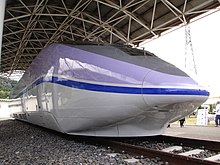You can help expand this article with text translated from the corresponding article in Japanese. (June 2023) Click for important translation instructions.
|
| 500-900 series "WIN350" | |
|---|---|
 End car 500-906 preserved at Hakata Shinkansen Depot, October 2011 End car 500-906 preserved at Hakata Shinkansen Depot, October 2011 | |
| In service | 1992–1995 |
| Manufacturer | Hitachi, Kawasaki Heavy Industries |
| Constructed | 1992 |
| Scrapped | 1996 |
| Number built | 6 vehicles |
| Number in service | None |
| Number preserved | 2 vehicles |
| Number scrapped | 4 vehicles |
| Formation | 6 cars |
| Fleet numbers | W0 |
| Operators | JR West |
| Depots | Hakata |
| Lines served | Sanyo Shinkansen |
| Specifications | |
| Car body construction | Aluminium alloy, Honeycomb structure |
| Car length | 26.55 m (87 ft 1 in) (end cars) 25 m (82 ft 0 in) (intermediate cars) |
| Width | 3,380 mm (11 ft 1 in) |
| Maximum speed | 350 km/h (217 mph)(nominal) |
| Traction system | 300 kW (402 hp) 3-phase motors |
| Power output | 7,200 kW (9,655 hp) |
| Electric system(s) | 25 kV AC 60 Hz |
| Current collector(s) | Pantograph |
| Safety system(s) | ATC |
| Track gauge | 1,435 mm (4 ft 8+1⁄2 in) standard gauge |
"WIN350" was the name given to the 500-900 series (500系900番台) 6-car experimental high-speed Shinkansen train developed in 1992 by the West Japan Railway Company (JR West) in Japan to test technology to be incorporated in next-generation shinkansen trains expected to operate at speeds of 350 km/h (217 mph) from 1994. Initially given the designation "500X", the name "WIN350" stood for "West Japan's Innovation for operation at 350 km/h".
Design
Cars 500-901 to 500-903 were built by Kawasaki Heavy Industries in Hyogo Prefecture. Cars 500-904 to 500-906 were built by Hitachi in Yamaguchi Prefecture.
The front-end designs of the two driving vehicles (500-901 and 500-906) were slightly different, with 500-906 featuring a "cockpit" style arrangement. The external livery was purple and light grey, with darker purple lining.
All axles were motored, using 300 kW three-phase motors, and cars were equipped with tilting and active suspension.
Internally, only car 4 was fitted with passenger seats, with 10 rows of 3+2 standard-class seating and 5 rows of 2+2 Green class (first class) seating.
Formation
The 6-car set, designated "W0", was formed as follows.
| Car No. | 1 | 2 | 3 | 4 | 5 | 6 |
|---|---|---|---|---|---|---|
| Designation | M'1c | M'1p | M1 | M2 | M'2p | M2c |
| Numbering | 500-901 | 500-902 | 500-903 | 500-904 | 500-905 | 500-906 |
Initially, cars 1, 2, and 5 were fitted with pantographs.
History
The WIN350 train was delivered to Hakata Shinkansen Depot in April 1992.
On 6 August 1992, the train recorded a Japanese national speed record of 345.8 km/h (214.9 mph) on the San'yō Shinkansen. Two days later, on 8 August 1992, the train recorded a Japanese national speed record of 350.4 km/h (217.7 mph) on the San'yō Shinkansen between Ogōri (now Shin-Yamaguchi) and Shin-Shimonoseki.
The WIN350 trainset was withdrawn on 31 May 1996, and a special farewell ceremony was held at Hakata Shinkansen Depot.
Preservation

End car 500-901 is preserved outdoors at the RTRI large-scale wind tunnel test facility in Maibara, Shiga. Initially expected to be moved to the Modern Transportation Museum in Osaka, end car 500-906 was stored at Hakata Shinkansen Depot until being scrapped in May 2024.
References
- ^ JR全車輛ハンドブック'93 [JR Rolling Stock Handbook 1993]. Japan: Neko Publishing. 1993.
- ^ プロトタイプの世界 - Prototype World. Japan: Kōtsū Shimbunsha. December 2005. pp. 56–59. OCLC 170056962.
- ^ Semmens, Peter (1997). High Speed in Japan: Shinkansen - The World's Busiest High-speed Railway. Sheffield, UK: Platform 5 Publishing. ISBN 1-872524-88-5.
- ^ "500系新幹線電車" [500 series Shinkansen EMU]. Japan Railfan Magazine. Vol. 32, no. 374. Japan: Kōyūsha. June 1992. pp. 18–19.
- ^ "500系新幹線試験電車" [500 series Experimental Shinkansen EMU]. Japan Railfan Magazine. Vol. 32, no. 375. Japan: Koyusha. July 1992. pp. 52–58.
- 新幹線電車データブック2011 [Shinkansen Databook 2011]. Japan: JRR. March 2011. p. 95. ISBN 978-4-330-19811-8.
- 鉄道のテクノロジーVol1:新幹線 [Railway Technology Vol.1: Shinkansen]. Japan: Sanei Mook. April 2009. pp. 122–124. ISBN 978-4-7796-0534-5.
External links
![]() Media related to 500-900 series "WIN350" at Wikimedia Commons
Media related to 500-900 series "WIN350" at Wikimedia Commons
| Shinkansen | ||||||||||||||||||||
|---|---|---|---|---|---|---|---|---|---|---|---|---|---|---|---|---|---|---|---|---|
| Lines |
|     | ||||||||||||||||||
| Service names |
| |||||||||||||||||||
| Train types |
| |||||||||||||||||||
| Operators |
| |||||||||||||||||||
| Builders and owners |
| |||||||||||||||||||
| People | ||||||||||||||||||||
| Experimental and prototype high-speed trains | |
|---|---|
| China | |
| France | |
| France & Germany | |
| Germany | |
| Japan | |
| Korea, South | |
| USSR | |
| United Kingdom | |
| USA & Canada | |
| |